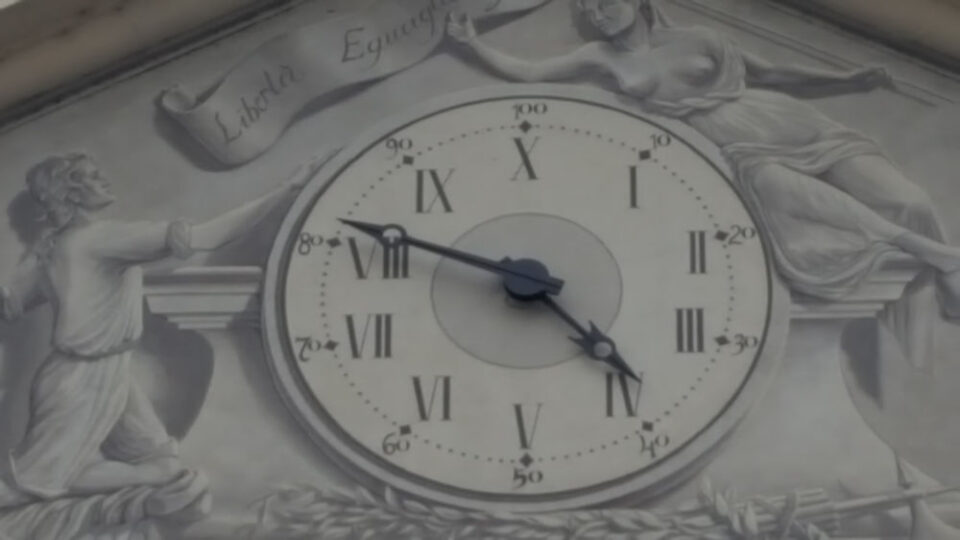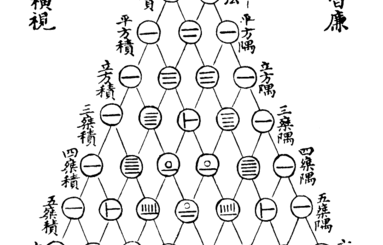Prime numbers and factorization
The practical reasons of this choice are very ancient: the idea was adopted by Babylonians about 4000 years ago.
But, on October 5th 1793, in full French Revolution, another solution was attempted. After a proposal by the official Jean-Charles de Borda, an odd decree was issued:
“The day, from midnight to midnight, is divided into ten parts, each part into ten other ones and so on, up to the smallest measurable time portion.”

The decimal clock on the fronton of Einaudi Palace at Chivasso (near Turin, Italy)
So, in revolutionary France, the “decimal day” was introduced, divided into 10 “decimal hours”, divided into 10 “decimal minutes”, divided in turn into 10 “decimal seconds”. It would be a… revolution in the revolution, but very soon the decree decayed, because it was very clear that the original subdivision, in which the day was divided into 24 hours, the hour into 60 minutes and the minute into 60 seconds, was far more convenient to be used. But so, what’s special about the number 60? The answer is tightly connected to the decomposition into prime numbers, which we’ll explain here.
What’s a prime number?
A prime number is an integer number greater than 1 which is divisible only by 1 or by itself.
In order to check if a number is prime, we can try to divide it by all other numbers, apart from 1, less than itself. If it’s not prima, then, for at least one of those numbers, we should have as a result a non-decimal number.
Let’s divide by 2: \frac{\displaystyle 5}{\displaystyle 2} = 2.5
Let’s divide by 3: \frac{\displaystyle 5}{\displaystyle 3} \approx 1.67
Let’s divide by 4: \frac{\displaystyle 5}{\displaystyle 4} = 1.25
We always obtained as a result a decimal number: so we have checked that 5 is prime.
Let’s check if 15 is prime:
Let’s divide by 2: \frac{\displaystyle 15}{\displaystyle 2} = 7.5
Let’s divide by 3: \frac{\displaystyle 15}{\displaystyle 3} = 5
The last division gave as a result an integer number, so 15 is not prime.
Though such a definition may seem elementary or of little interest, prime numbers are a very important category of numbers, still source of research works and interesting facts in the field of Mathematics.
Some prime numbers to remember
There are infinitely many prime numbers, but it’s easy to remember the first ten:
2, 3, 5, 7, 11, 13, 17, 23, 29, 31 …
The first proof that prime numbers are infinite was attributed to Euclid, a Greek mathematician who lived more than 2000 years ago!
Divisibility rules
In order to check if a number is divisible by another one, of course is possible to do the division and check if the result is an integer number, but often it’s more convenient to use divisibility rules. In this section we’ll show the divisibility rules for prime numbers from 2 to 11. There are also divisibility rules for bigger prime numbers, but they require many passages and longer calculations, which move away from the aim of illustrating the decomposition into prime numbers.
Divisibility by 2
A number is divisible by 2 if its last digit is 0, 2, 4, 6 or 8, i.e. if it’s even.
The number 5593 is not divisible by 2 because its last digit is 3, so it’s neither of 0, 2, 4, 6 or 8.
Divisibility by 3
A number is divisible by 3 if the sum of its digits is 3 of a multiple of it.
Divisibility by 5
A number is divisible by 5 if its last digit is 0 or 5.
The number 3557 is not divisible by 5, because its last digit is 7, so it’s neither 0 or 5.
Divisibility by 7
From the number 7 on, divisibility rules become less immediate and more laborious. In order to check the divisibility by 7 you have to follow the following passages:
- You write the number without the last digit;
- You take the last digit alone and double it;
- You do the subtraction of the two obtained numbers (the first one minus the second one);
- You check if the result is divisible by 7. If the number is 70 or less you can use the multiplicative table, otherwise you repeat the procedure.
The last digit, taken alone, is 5, which, doubled, becomes 10.
Let’s do the subtraction between the two obtained numbers: 38 – 10 = 28.
The obtained number is 70 or less: so let’s check if it’s in the multiplicative table of 7. We’ll obtain that 28 = 7 · 4, so 28 is divisible by 7.
So, 385 is divisible by 7.
The number 2877 is divisible by 7.
The last digit, taken alone, is 7, which, doubled, becomes 14.
Let’s do the subtraction between the two obtained numbers: 287 – 14 = 273.
Now we have to establish if 273 is divisible by 7. Being greater than 70, we cannot use the multiplicative table of 7, so it’s necessary to repeat the procedure.
The number 273, without the last digit, becomes 27.
The last digit, taken alone, is 3, which, doubled, becomes 6.
Let’s do the subtraction between the two obtained numbers: 27 – 6 = 21.
The obtained number is 70 or less, and we know from the multiplicative table that 21 = 7 · 3, so 273 is divisible by 7.
So, in turn, 2877 is divisible by 7.
The number 3781 is not divisible by 7.
The last digit, taken alone, is 1, which, doubled, becomes 2.
Let’s do the subtraction between the two obtained numbers: 378 – 2 = 376.
Now we have to determine if 376 is divisible by 7. Being greater than 70, we cannot use the multiplicative table of 7, so we have to repeat the procedure.
The number 376, without the last digit, becomes 37.
The last digit, taken alone, is 6, which, doubled, becomes 12.
Let’s do the subtraction between the two obtained numbers: 37 – 12 = 25.
The result is 70 or less, but it’s not in the multiplicative table of 7, so it’s not divisible by 7.
So, 376 is not divisible by 7.
So, in turn, 3781 is not divisible by 7.
Divisibility by 11
In order to check the divisibility by 11 you have to follow the following passages:
- You sum up the digits at odd positions starting from the left (i.e. the first, the third, and so on);
- You sum up the digits at even positions starting from the left (i.e. the second, the fourth, and so on);
- You do the subtraction between the two obtained numbers (the greatest minus the smallest);
- You check if the obtained result is 0 or is divisible by 11. If the number is 110 or less you can use the multiplicative table, otherwise you repeat the procedure.
Let’s sum up the second, the fourth and the sixth digit: 4 + 2 + 1 = 7.
Let’s do the subtraction: 18 – 7 = 11.
Of course 11 is divisible by 11.
So, in turn, 247291 is divisible by 11.
The number 191719 is divisible by 11.
Let’s sum up the second, the fourth and the sixth digit: 9 + 7 + 9 = 25.
Let’s do the subtraction: 25 – 3 = 22.
The obtained number is 110 or less, and we know from the multiplicative tables that 22 = 11 · 2, so 22 is divisible by 11.
So, in turn, 191719 is divisible by 11.
The number 371 is not divisible by 11.
The second digit is 7. In this case there are no other digits to be summed up.
Let’s do the subtraction: 7 – 4 = 3.
The obtained number is 110 or less, but it’s not in the multiplicative table of 11, so it’s not divisible by 11.
So, in turn, 371 is not divisible by 11.
Factorization
Writing an integer number as a product of prime numbers is an operation called factorization.
In order to factorize small numbers, we can often get by with multiplicative tables; when they are not sufficient, or for greater numbers, we have to rely on divisibility rules.
A useful notation for factorizing a number easily is to draw a small table of two columns. At the first row of the left column we write the number which we want to decompose.
After having found a prime number which is a divisor of the number on the left, we write it on the right column, we do the division and we write the result in the left column under the previous number. We proceed until the last number on the left is 1.
At the end we can write the initial number as the product of all the numbers in the right column.
| 60 | 2 |
| 30 | 2 |
| 15 | 3 |
| 5 | 5 |
| 1 |
Hence 60 = 22 · 3 · 5
Why an hour is made up of 60 minutes?
The number 60 has many divisors, so that we can divide an hour into many different time intervals without making approximations. You can check that:
Which implies that we can divide an hour into intervals of 2, 3, 5, 10, 15, 20 or 30 minutes! This idea is so effective that it’s still beleived optimal for measuring the time of our days.
Integer number
Integer numbers are the ones written without decimal digits, i.e. without the point.Divisibility
Equivalently, the relationship can also be expressed by saying that b is a divisor of a.
Powers
The operation of multiplying a number by itself many times can be written in a more concise way as a power. The exponent indicates how many times the number has been multiplied by itself.8 \cdot 8 \cdot 8 \cdot 8 = 8^4. The exponent of 8 is 4 because 8 has been multiplied by itself four times.

